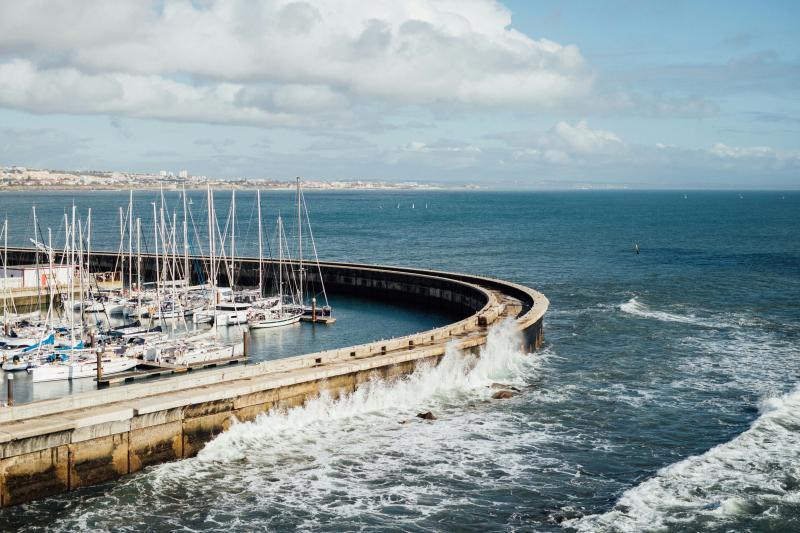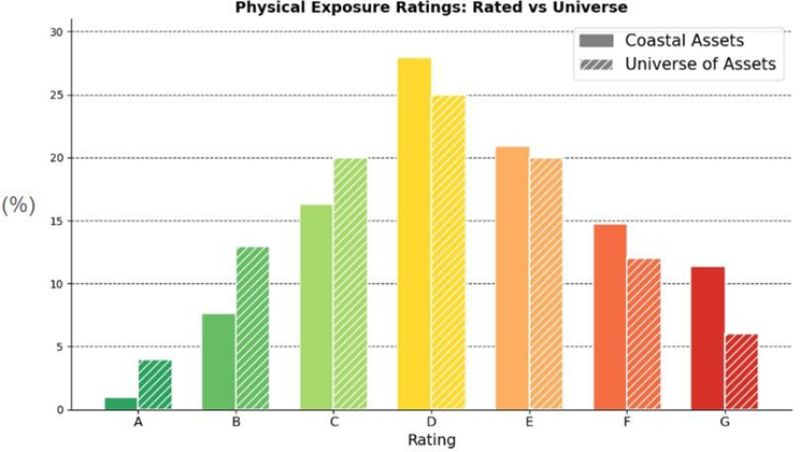Turning the Tide: Measuring Climate Risk to Transform Coastal Infrastructure Resilience

Many of the world’s largest cities, ports and industrial areas are located on the coast. Some 1% of the world's population lives in low-elevation coastal areas that are less than 10 metres above sea level (Reimann et al. 2023) and 40% of the global population lives less than100 km from the sea (OHCHR, 2025). This access to maritime trade, resources, tourism and fishing has supported strong economic growth, but a consequence is that much of the world’s critical infrastructure occupies costal site; this geographic concentration exposes these assets to the most serious risks of climate change.
On the front line of hazards, these infrastructures are becoming sensitive points, whose failure would have major economic, environmental and social consequences. To stave off such events, it has become imperative to understand these assets’ vulnerability, find reliable assessment tools and measure their capacity to adapt.
Why are coastal infrastructures vulnerable?
Coastal infrastructure is particularly exposed to extreme events such as floods, storms and tropical cyclones. Coastal flooding, often referred to as marine submersion, is amplified by rising sea level (Neumann et al. 2015, Tahvildari and Castrucci 2021). These events cause damage and disrupt activities. Erosion also makes coastlines more fragile, and the increased frequency of these events leaves less time for infrastructure to regenerate or be reinforced.
Infrastructure sectors are exposed to the major hazards of climate change in different ways. For example, roads, railways and electricity generation are particularly vulnerable to flooding; ports, airports, telecommunications networks and power lines are sensitive to storms and tropical cyclones; droughts affect water supply and river transport.
Recent climate disasters demonstrate their impact on societies and infrastructure. Hurricane Katrina (2005, United States) flooded 80% of New Orleans, causing more than 1,800 deaths and USD125 billion in damage(National Weather Service, 2006), including damage to 100 platforms and 558 pipelines (USGAO 2014). In 2010, Storm Xynthia submerged the French Atlantic coast, causing 47 deaths and an estimative USD4 billion in losses (Mateos et al. 2023). More recently, Cyclone Idai (2019, Mozambique) paralysed the port of Beira, causing more than 1,200 deaths and USD2 billion in damage (EM-DAT; Delforge et al., 2025). The floods in Europe in 2021 severely disrupted transport, electricity, water, telecommunications and social infrastructure. Water and electricity infrastructure was restored as a priority, while transport infrastructure took the longest to recover (Koks et al., 2021).
These climate disasters may become more frequent and destructive, confirming the urgency of preparing for climate change. Many of the impacts observed are often due to interconnections between infrastructures (i.e. cascading effects), where the disruption of a specific service results from an initial failure in another infrastructure sector (Verschuur et al., 2024).
Assessing vulnerability: a common language is needed
Comparing the vulnerability of coastal infrastructure is difficult due to heterogeneous methods of measurement, subjective criteria and the lack of any common framework. This paucity of standardisation makes investment decisions complex: how can we know where to prioritise action? A clear, scientific and shared rating system would make it possible to identify the most exposed assets, promote those that are adapting and guide the decisions of local authorities, businesses and investors.
This challenge can be resolved with approaches based on financial materiality, which assess climate impacts through their concrete economic consequences (business disruption, financial losses and repair costs). At the EDHEC Climate Institute, this measurement of risk across a large number of assets has enabled us to develop a means of assessing infrastructure risks in a comparable way.
Understanding climate risk methodically
Accurately quantifying physical risk is a central pillar of assessing climate impacts on an asset or business. We base our gauge on a joint analysis of the probability of a hazard occurring (e.g. a flood) and its expected intensity, taking into account changes linked to climate change. We associate damage functions from scientific literature with different hazards, specific to the nature of the asset (residential, commercial or industrial building) and the region, in order to reflect local construction characteristics.
These functions enable us to translate event risks into potential losses: a 100-year flood (probability) causing two metres of flooding (intensity) can represent up to 50% of the reconstruction value of a house in France. This type of indicator (damage expressed as a percentage) is a robust solution for linking the intensity of an event to the extent of expected damage and provides an essential basis for anticipating, comparing and managing climate risks (Huizinga et al., 2017; Prahl et al. 2016).
Our analysis also incorporates transition risks related to the economic and regulatory consequences of the low-carbon transition. Infrastructure assets with high CO₂ emissions, located in protected areas or subject to stricter environmental standards, may see their operating costs increase or their permits challenged. For example, a coastal plant dependent on fossil fuels could close if a carbon tax is introduced, while a gas terminal could become a stranded asset in the event of a sustained fall in demand.
These data sets, developed by the EDHEC Climate Institute, can be used by other players to further research into climate change risk. For example, SCR (Scientific Climate Ratings) has used our data to develop climate infrastructure ratings. SCR's exposure ratings (Potential Climate Exposure Ratings), freely available on their website, allow coastal assets, which represent 23% of more than 6,000 infrastructure assets, to be compared with other assets. Exposure is expressed on the A to G scale, A denotes the lowest risk, while G denotes the highest risk compared to the complete universe of assets.
Figure 1 shows that these coastal assets are generally riskier than assets as a whole, as they face more high risks (F, G) and have fewer A and B ratings.

Figure 1: Comparison of potential climate exposure ratings between coastal assets
and all assets included in the Scientific Climate Ratings assessment
Making industrial players the drivers of change
An asset’s resilience refers to its ability to absorb a climate shock, adapt or reorganise while maintaining its essential functions (Walker et al., 2004). In other words, it is the ability of an asset to return to normal operation following a shock.
Industrial players must be actively involved: their resilience to climate shocks, their business continuity and their ability to meet societal expectations are key to their long-term survival.
Our research incorporates resilience and decarbonisation actions through the ClimaTech initiative, which assesses resilience and decarbonisation actions according to their effectiveness (reduction of physical or transition risk) and cost, sector by sector. This approach limits greenwashing and highlights the economic benefits of good practices: effective action reduces risk and improves ratings, on an objective and comparable basis; the more action is taken, the better the rating.
Conclusion
The scale of the risks involved makes it vital to take rapid action: without appropriate measures, damage related to coastal flooding could increase 150-fold by 2080, highlighting the urgency of investing today in infrastructure protection and adaptation (Tiggeloven et al., 2020).
In the face of climate change, coastal infrastructure is at a turning point: on the front line, it presents major economic, social and environmental challenges. Protecting it requires a rigorous, comparable and transparent assessment of risks, taking into account financial materiality and climate change. Both public and private actors need to make decisions, invest and promote concrete actions. Accuraltely measuring the risks involved is the first essential step to making them visible – and impossible to ignore.
References
- Delforge, D., Wathelet, V., Below, R., Sofia, C.L., Tonnelier, M., van Loenhout, J. A., & Speybroeck, N. (2025). EM-DAT: the emergency events database. International Journal of Disaster Risk Reduction, 105509.
- Huizinga, J., De Moel, H., & Szewczyk, W. (2017). Global flood depth-damage functions: Methodology and the database with guidelines (No. JRC105688). Joint Research Centre.
- Koks, E., Van Ginkel, K., Van Marle, M., & Lemnitzer, A. (2021). Brief communication: Critical infrastructure impacts of the 2021 mid-July western European flood event. Natural Hazards and Earth System Sciences Discussions,1-11.
- Mateos, R. M., Sarro, R., Díez-Herrero, A., Reyes-Carmona, C., López-Vinielles, J., Ezquerro, P., ... & Monserrat, O. (2023). Assessment of the socio-economic impacts of extreme weather events on the coast of southwest Europe during the period 2009–2020. Applied Sciences, 13(4), 2640.
- National Weather Service, 2006. Hurricane Katrina Service Assessment Report (Report). Silver Spring, Maryland: National Oceanic and Atmospheric Administration. https://www.nhc.noaa.gov/data/tcr/AL122005_Katrina.pdf. Last Access October 12, 2025.
- Neumann, J.E, Emanuel, K., Ravela. S., Ludwig, L., Kirshen, P., Bosma, K. & Martinich, J. (2015). Joint effects of storm surge and sea-level rise on US coasts: new economic estimates of impacts, adaptation, and benefits of mitigation policy. Climate Change 129: 337–49
- Tahvildari, N., & Castrucci, L. (2021). Relative sea level rise impacts on storm surge flooding of transportation infrastructure. Natural Hazards Review. 22:1–17
- Office of the United Nations High Commissioner for Human Rights (2025). Ocean issues are human rights issues, says UN expert [Press release, 6 March 2025]. Retrieved 6 from https://www.ohchr.org/en/press-releases/2025/03/ocean-issues-are-human-rights-issues-says-un-expert ohchr.org.
- Prahl, B. F., Rybski, D., Boettle, M., & Kropp, J. P. (2016). Damage functions for climate-related hazards: unification and uncertainty analysis. Natural Hazards and Earth System Sciences 16(5): 1189-1203.
- Reimann, L., Vafeidis, A. T., & Honsel, L. E. (2023). Population development as a driver of coastal risk: Current trends and future pathways. Cambridge Prisms: Coastal Futures, 1, e14.
- Tiggeloven, T., De Moel, H., Winsemius, H. C., Eilander, D., Erkens, G., Gebremedhin, E., ... & Ward, P. J. (2020). Global-scale benefit–cost analysis of coastal flood adaptation to different flood risk drivers using structural measures. Natural Hazards and Earth System Sciences, 20(4), 1025-1044.
- USGAO (2014). Climate change: energy infrastructure risks and adaptation efforts Report to Congressional Requesters (United States Government Accountability Office) (available at: www.gao.gov/products/gao-14-74).
- Verschuur, J., Fernández-Pérez, A., Mühlhofer, E., Nirandjan, S., Borgomeo, E., Becher, O.,...& Hall, J.W. (2024). Quantifying climate risks to infrastructure systems: A comparative review of developments across infrastructure sectors. PLoS Climate 3(4): e0000331.
- Walker, B., Holling, C. S., Carpenter, S. R., & Kinzig, A. (2004). Resilience, adaptability and transformability in social–ecological systems. Ecology and Society 9(2): 5. https://doi.org/10.5751/ES-00650-00205.
